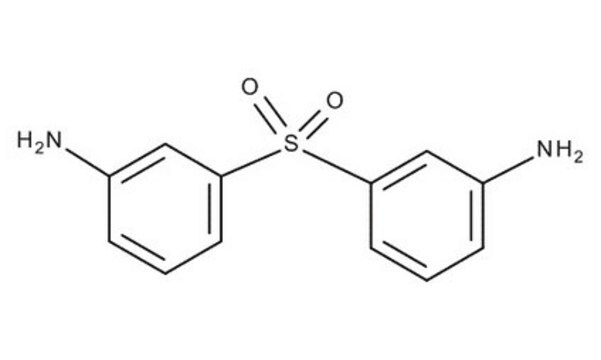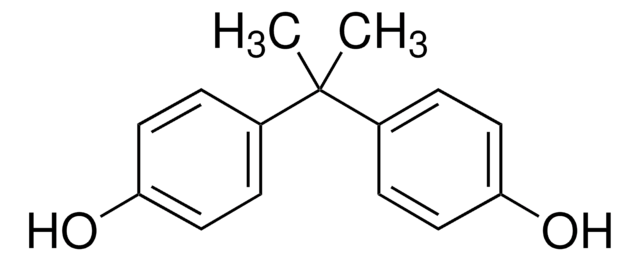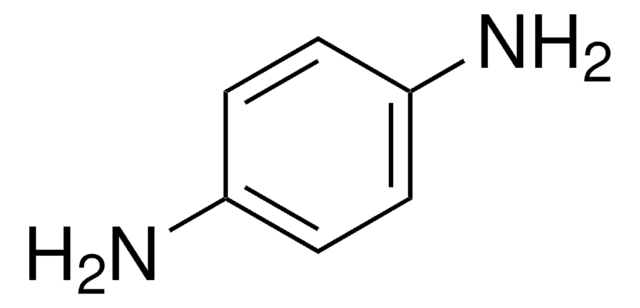8.22289
1-Naphthol
for synthesis
Sinonimo/i:
1-Naphthol, 1-Hydroxynaphthalene
About This Item
Prodotti consigliati
Tensione di vapore
1.3 hPa ( 94 °C)
Livello qualitativo
Saggio
≥99% (GC)
Stato
solid
Temp. autoaccensione
510 °C
Potenza
1870 mg/kg LD50, oral (Rat)
880 mg/kg LD50, skin (Rabbit)
tecniche
UV/Vis spectroscopy: suitable
P. ebollizione
288 °C/1013 hPa
Punto di fusione
94-96 °C
Temp. transizione
flash point 125 °C
Solubilità
0.1 g/L
Densità
1.28 g/cm3 at 20 °C
Densità bulk
450 kg/m3
Temperatura di conservazione
2-30°C
InChI
1S/C10H8O/c11-10-7-3-5-8-4-1-2-6-9(8)10/h1-7,11H
KJCVRFUGPWSIIH-UHFFFAOYSA-N
Cerchi prodotti simili? Visita Guida al confronto tra prodotti
Applicazioni
<li><strong>Real-time deflection and friction force imaging by bimorph-based resonance-type high-speed scanning force microscopy in the contact mode.</strong>: This study employs fluorine-doped tin oxide coated glass slides in a novel microscopy technique that enhances real-time imaging capabilities, demonstrating its applicability in high-speed, high-resolution surface analysis (Cai et al., 2014).</li>
<li><strong>Langmuir-Blodgett films of self-assembled (alkylether-derivatized Zn phthalocyanine)-(C imidazole adduct) dyad with controlled intermolecular distance for photoelectrochemical studies.</strong>: This research explores the use of fluorine-doped tin oxide as a substrate for Langmuir-Blodgett films, focusing on their potential in creating highly organized molecular assemblies for enhanced photoelectrochemical applications (Obraztsov et al., 2014).</li>
<li><strong>Formation of an electron hole doped film in the α-Fe2O3 photoanode upon electrochemical oxidation.</strong>: The paper describes the advantageous characteristics of fluorine-doped tin oxide in forming electron hole doped films on α-Fe2O3 photoanodes, pivotal for improving the efficiency of photoelectrochemical cells (Gajda-Schrantz et al., 2013).</li>
<li><strong>BiSI Micro-Rod Thin Films: Efficient Solar Absorber Electrodes</strong>: Investigates the role of fluorine-doped tin oxide coated glass slides in enhancing the photoelectrochemical properties of BiSI micro-rod thin films, suggesting potential applications in solar energy conversion and storage systems (Hahn et al., 2012).</li>
</ul>
Risultati analitici
Melting range (lower value): ≥ 94 °C
Melting range (upper value): ≤ 96 °C
Identity (IR): passes test
Avvertenze
Danger
Indicazioni di pericolo
Classi di pericolo
Acute Tox. 3 Dermal - Acute Tox. 4 Oral - Aquatic Acute 1 - Aquatic Chronic 3 - Eye Dam. 1 - Skin Irrit. 2 - Skin Sens. 1A - STOT SE 2 Oral - STOT SE 3
Organi bersaglio
Kidney, Respiratory system
Codice della classe di stoccaggio
6.1C - Combustible acute toxic Cat.3 / toxic compounds or compounds which causing chronic effects
Classe di pericolosità dell'acqua (WGK)
WGK 1
Punto d’infiammabilità (°F)
257.0 °F - closed cup
Punto d’infiammabilità (°C)
125 °C - closed cup
Certificati d'analisi (COA)
Cerca il Certificati d'analisi (COA) digitando il numero di lotto/batch corrispondente. I numeri di lotto o di batch sono stampati sull'etichetta dei prodotti dopo la parola ‘Lotto’ o ‘Batch’.
Possiedi già questo prodotto?
I documenti relativi ai prodotti acquistati recentemente sono disponibili nell’Archivio dei documenti.
I clienti hanno visto anche
Il team dei nostri ricercatori vanta grande esperienza in tutte le aree della ricerca quali Life Science, scienza dei materiali, sintesi chimica, cromatografia, discipline analitiche, ecc..
Contatta l'Assistenza Tecnica.











